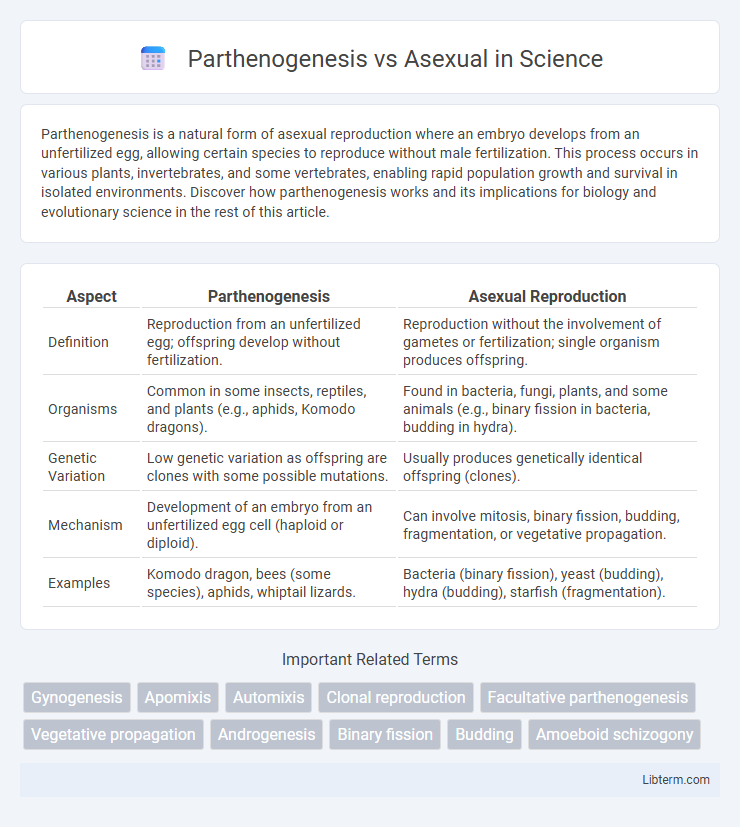Parthenogenesis is a natural form of asexual reproduction where an embryo develops from an unfertilized egg, allowing certain species to reproduce without male fertilization. This process occurs in various plants, invertebrates, and some vertebrates, enabling rapid population growth and survival in isolated environments. Discover how parthenogenesis works and its implications for biology and evolutionary science in the rest of this article.
Table of Comparison
| Aspect | Parthenogenesis | Asexual Reproduction |
|---|---|---|
| Definition | Reproduction from an unfertilized egg; offspring develop without fertilization. | Reproduction without the involvement of gametes or fertilization; single organism produces offspring. |
| Organisms | Common in some insects, reptiles, and plants (e.g., aphids, Komodo dragons). | Found in bacteria, fungi, plants, and some animals (e.g., binary fission in bacteria, budding in hydra). |
| Genetic Variation | Low genetic variation as offspring are clones with some possible mutations. | Usually produces genetically identical offspring (clones). |
| Mechanism | Development of an embryo from an unfertilized egg cell (haploid or diploid). | Can involve mitosis, binary fission, budding, fragmentation, or vegetative propagation. |
| Examples | Komodo dragon, bees (some species), aphids, whiptail lizards. | Bacteria (binary fission), yeast (budding), hydra (budding), starfish (fragmentation). |
Introduction to Parthenogenesis and Asexual Reproduction
Parthenogenesis is a specific form of asexual reproduction where offspring develop from unfertilized eggs, commonly observed in certain reptiles, insects, and plants. Asexual reproduction encompasses various methods such as binary fission, budding, and vegetative propagation, enabling organisms to reproduce without genetic contribution from a mate. Both processes produce genetically identical or nearly identical offspring, but parthenogenesis is characterized by embryonic development from the female gamete alone.
Defining Parthenogenesis: Unique Mechanisms
Parthenogenesis is a specialized form of asexual reproduction where offspring develop from unfertilized eggs, bypassing the need for male genetic contribution. This process involves unique mechanisms such as automixis, where meiosis is modified to restore diploidy, or apomixis, which allows mitotic division to produce clones. Unlike general asexual reproduction methods such as binary fission or budding, parthenogenesis enables genetic variation through recombination or chromosomal segregation, depending on the species.
Understanding Asexual Reproduction: Types and Processes
Asexual reproduction encompasses various processes, including parthenogenesis, where offspring develop from unfertilized eggs, ensuring genetic consistency with the parent. Other forms of asexual reproduction include binary fission, budding, and vegetative propagation, each facilitating rapid population growth without genetic recombination. Understanding these mechanisms provides insight into evolutionary advantages and organisms' adaptability in stable environments.
Key Differences Between Parthenogenesis and Asexual Reproduction
Parthenogenesis is a specific type of asexual reproduction where an offspring develops from an unfertilized egg, commonly observed in certain reptiles, amphibians, and invertebrates. Unlike broader asexual reproduction methods such as binary fission, budding, or vegetative propagation, parthenogenesis involves the development of a new individual without sperm involvement but still follows meiosis or mitosis depending on the species. Key differences include the genetic diversity produced, as parthenogenesis can result in partial genetic variation due to meiosis, whereas most asexual reproduction produces genetically identical clones.
Evolutionary Significance of Parthenogenesis
Parthenogenesis, a form of asexual reproduction where offspring develop from unfertilized eggs, offers evolutionary advantages by enabling rapid population growth and colonization in stable environments. Unlike general asexual reproduction, parthenogenesis can maintain genetic diversity through mechanisms like automixis, reducing the risk of deleterious mutations. This reproductive strategy provides resilience in fluctuating conditions by preserving beneficial gene combinations without the need for mating, highlighting its evolutionary significance in various species.
Common Organisms Exhibiting Parthenogenesis
Parthenogenesis is a specialized form of asexual reproduction where offspring develop from unfertilized eggs, commonly observed in organisms like aphids, certain species of lizards such as whiptail lizards, and some sharks including the bonnethead shark. Unlike general asexual reproduction methods like binary fission or budding found in bacteria and hydra, parthenogenesis results in genetically similar but not always identical offspring due to mechanisms like automixis. This reproductive strategy allows rapid population growth in stable environments and is particularly advantageous for species with limited mating opportunities.
Examples of Asexual Reproduction in Nature
Asexual reproduction in nature includes various methods such as binary fission in bacteria, budding in hydra, and vegetative propagation in plants like strawberries. Parthenogenesis, a specific form of asexual reproduction, occurs in species such as komodo dragons and certain aphids, where females produce offspring without fertilization. These examples highlight the diversity of asexual reproduction strategies across different biological kingdoms.
Genetic Implications and Variability
Parthenogenesis, a form of asexual reproduction, involves offspring development from an unfertilized egg, resulting in limited genetic variability due to the offspring's near-identical genetic makeup to the mother. In contrast, asexual reproduction methods like binary fission or budding produce clones with little to no genetic diversity, reducing adaptability to environmental changes. Genetic implications of parthenogenesis include potential accumulation of deleterious mutations, whereas broader asexual reproduction may limit evolutionary potential compared to sexual reproduction.
Advantages and Disadvantages Compared
Parthenogenesis is a form of asexual reproduction where offspring develop from unfertilized eggs, ensuring rapid population increase and genetic continuity without a mate, but it limits genetic diversity, increasing vulnerability to environmental changes. Asexual reproduction, including methods like binary fission or budding, allows organisms to reproduce quickly and efficiently with minimal energy investment, yet it results in clones that may lack adaptability to evolving threats. Both reproductive strategies excel in stable environments but face disadvantages in adapting to dynamic ecosystems due to reduced genetic variation.
Future Research and Applications in Reproductive Biology
Future research in reproductive biology will explore the genetic mechanisms and epigenetic regulation underlying parthenogenesis to enhance asexual reproduction techniques in agriculture and conservation. Advances in CRISPR gene editing and stem cell technologies may enable controlled induction of parthenogenetic development in mammals, potentially revolutionizing infertility treatments and species preservation. Applications targeting parthenogenesis could optimize clonal propagation in endangered species and improve livestock breeding efficiency through precise manipulation of developmental pathways.
Parthenogenesis Infographic

 libterm.com
libterm.com